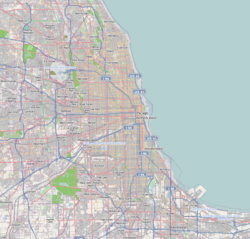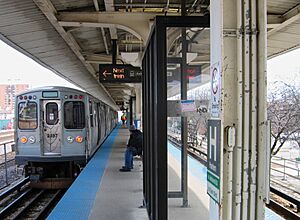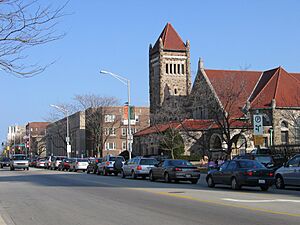Oak Park, Illinois facts for kids
Quick facts for kids
Oak Park, Illinois
|
|||
|---|---|---|---|
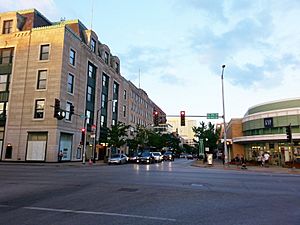
Lake Street at dusk
|
|||
|
|||

Location of Oak Park in Cook County, Illinois
|
|||
| Country | United States | ||
| State | Illinois | ||
| County | Cook | ||
| Township | Oak Park | ||
| Settled | 1835 | ||
| Incorporated (village) | 1902 | ||
| Government | |||
| • Type | Oak Park Board of Trustees | ||
| Area | |||
| • Total | 4.70 sq mi (12.17 km2) | ||
| • Land | 4.70 sq mi (12.17 km2) | ||
| • Water | 0.00 sq mi (0.00 km2) | ||
| Elevation | 620 ft (190 m) | ||
| Population
(2020)
|
|||
| • Total | 51,282 | ||
| • Density | 11,613.40/sq mi (4,484.14/km2) | ||
| Demonym(s) | Oak Parker | ||
| Time zone | UTC−6 (CST) | ||
| • Summer (DST) | UTC−5 (CDT) | ||
| ZIP code(s) |
60301 to 60304
|
||
| Area code(s) | 708 | ||
| FIPS code | 17-54885 | ||
Oak Park is a village in Cook County, Illinois, United States. It is right next to the big city of Chicago. About 54,318 people live here, making it the 26th largest town in Illinois.
Oak Park was first settled in 1835. It became an official village in 1902. At that time, it separated from another town called Cicero. Oak Park is very close to the smaller town of River Forest. They even share a high school, Oak Park and River Forest High School.
A famous architect named Frank Lloyd Wright lived in Oak Park starting in 1889. His unique building style greatly influenced the homes and buildings you see there. Over the years, Oak Park grew quickly. This was because railroads and streetcars made it easy for people to travel to jobs in Chicago. In 1968, Oak Park passed a special rule called the Open Housing Ordinance. This rule helped the village become and stay a place where people of all backgrounds could live together.
Today, Oak Park is known for being a diverse community. It is also known for its socially liberal politics. Many people vote in presidential elections here. Oak Park has good public transportation to Chicago. You can use the "L" train lines (Green Line and Blue Line) or the Metra train.
Contents
History of Oak Park
Early Settlement and Naming
In 1835, a family named Kettlestrings moved to this area from England. They built a farm and a house near what is now Lake Street and Harlem Avenue. More farmers and settlers soon came to the area.
Their land was called different names like Oak Ridge and Kettlestrings Grove. When the first post office opened, it couldn't use "Oak Ridge." Another town in Illinois already had that name. So, the post office chose "Oak Park," and that name stuck as the area grew. In 1902, it officially became the village of Oak Park.
How Railroads Helped Oak Park Grow
By 1850, a railroad was built through the settlement. This railroad later became the Chicago & Northwestern. In the 1850s, Oak Park was part of a new Chicago suburb called Cicero. The area's population grew a lot in the 1870s. Many people moved here after the Great Chicago Fire of 1871. More railroads and streetcars also made it easier to get to Chicago.
In 1872, Oak Park got its own train station. This started its fast growth as a suburb. By 1877, 39 trains ran daily between Oak Park and Chicago. More train and streetcar lines were added. Oak Park grew from 500 people in 1872 to over 39,000 by 1920. It became a very important suburb of Chicago.
As suburban homes continued to be built in the 1880s and 1890s, streetcars and elevated trains helped connect Oak Park commuters to jobs in downtown Chicago. One of the first streetcar lines used "dummy" trains. These trains had a special cover to hide the moving parts. This was so they wouldn't scare horses! This line started in 1881. It offered direct service to Chicago by 1888. A larger streetcar network opened in Oak Park in 1890. This system ran on Madison Street, Lake Street, and Harlem Avenue. Streetcar service stopped in 1947 and was replaced by buses.
The Lake Street Elevated Railroad (now the CTA Green Line) came to Oak Park in 1899–1901. The Metropolitan West Side Elevated Railroad (now the CTA Blue Line) came in 1905.
Becoming an Independent Village
The Village of Oak Park officially formed in 1902. It separated from Cicero after people voted for it. Most of the homes and buildings in Oak Park were built between 1892 and 1950. By 1930, the village had 64,000 people. It was even bigger than it is today! It was known as the "World's Largest Village."
Chicago also grew very fast in the 1800s. It became the second-largest city in the U.S. by 1900. Oak Park grew along with Chicago. Its good location and train connections helped it a lot.

Modern Oak Park
After World War II, Oak Park changed. A major highway, the Eisenhower Expressway, was built through the southern part of the village in the 1950s. Starting in the 1960s, Oak Park worked hard to welcome people from all backgrounds. It wanted to stay a stable and diverse community. The Open Housing Ordinance in 1968 helped keep the village ethnically diverse.
Oak Park used to have strict rules against selling alcohol. When the village was first formed, no alcohol could be sold. This rule was relaxed in 1973. Restaurants and hotels could then serve alcohol with meals. In 2002, some grocery stores were allowed to sell packaged alcohol. Today, you can easily find beer and wine, and there are many bars.
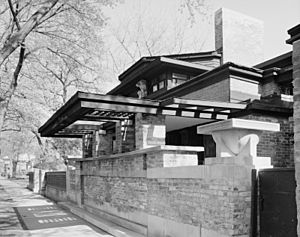
In 1889, Frank Lloyd Wright and his wife moved to Oak Park. He designed many homes and the Unity Temple church in the village. He left in 1911. Many people visit Oak Park to see the homes Wright designed. Oak Park has the largest collection of Wright-designed houses in the world. Since the 1970s, the village has worked to protect its historic buildings. Many buildings are now marked as historically important. There are also three historic districts.
Other interesting places include:
- Ernest Hemingway's birthplace and boyhood home.
- The Ernest Hemingway Museum.
- Homes of Tarzan creator Edgar Rice Burroughs.
- Wright's Unity Temple.
- Pleasant Home.
- The Oak Park-River Forest Historical Society.
Famous People from Oak Park
Oak Park and River Forest High School is a well-known school. Many famous people have graduated from there. These include:
- Nobel Prize-winning author Ernest Hemingway.
- Writer Michael Gerber.
- Rookie magazine founder Tavi Gevinson.
- Football Hall-of-Famer George Trafton.
- McDonald's founder Ray Kroc.
- City planner Walter Burley Griffin.
- Comedian Kathy Griffin.
- Basketball player Iman Shumpert.
- The voice of Homer Simpson, Dan Castellaneta.
Geography and Location
Oak Park is located just west of Chicago. Austin Boulevard is its eastern border with Chicago. North Avenue is its northern border. To the south, Oak Park borders Cicero and Berwyn. Harlem Avenue is its western border, next to Forest Park and River Forest.
Oak Park sits on the shore of an ancient lake called Lake Chicago. This lake covered most of Chicago during the last Ice Age. It was the early version of today's Lake Michigan. Ridgeland Avenue in eastern Oak Park was once the shoreline of this ancient lake.
A continental divide runs through Oak Park. This is a slight rise in the land. It separates water that flows to the Saint Lawrence River from water that flows to the Mississippi River. You can see plaques marking this divide on Lake Street and in Taylor Park.
Oak Park covers about 4.7 sq mi (12.17 km2) of land.
Transportation in Oak Park
Public Transit Options
You can get to Oak Park from Chicago using the "L" train lines. The Green Line and Blue Line both have five stations in Oak Park. Oak Park also has a station for Metra's Union Pacific West Line. Buses also provide service within Oak Park and to other nearby suburbs. These bus services are run by the CTA and Pace.
Roads and Highways
The Eisenhower Expressway is the main highway connecting Chicago and Oak Park. This highway also helps you get to O'Hare International Airport. Many main streets in Oak Park continue directly into Chicago.
Oak Park's streets are mostly in a grid pattern. Some local streets end in a cul-de-sac (a dead-end street with a loop). Oak Park has its own street numbering system. For east-west streets, numbers start at Austin Boulevard. For north-south streets, numbers start near Lake Street.
Biking in Oak Park
Augusta Boulevard in Oak Park is part of the Grand Illinois Trail. The start of the Illinois Prairie Path is also very close. Oak Park is considered a bicycle-friendly community. Its tree-lined streets and nearby trails attract many cyclists. You can easily reach Oak Park by train to go biking. Many streets have marked bicycle lanes.
Divvy bike sharing, which is popular in Chicago, came to Oak Park in 2016. However, the village decided to cancel the program in 2017. It was not found to be cost-effective.
Population and People
| Historical population | |||
|---|---|---|---|
| Census | Pop. | %± | |
| 1910 | 19,444 | — | |
| 1920 | 39,858 | 105.0% | |
| 1930 | 63,982 | 60.5% | |
| 1940 | 66,015 | 3.2% | |
| 1950 | 63,529 | −3.8% | |
| 1960 | 61,093 | −3.8% | |
| 1970 | 62,511 | 2.3% | |
| 1980 | 54,887 | −12.2% | |
| 1990 | 53,648 | −2.3% | |
| 2000 | 52,524 | −2.1% | |
| 2010 | 51,878 | −1.2% | |
| 2020 | 54,583 | 5.2% | |
| U.S. Decennial Census 2010 2020 |
|||
As of the 2020 census, there were 54,583 people living in Oak Park. There were 21,701 households. The village is home to a diverse group of people. About 60% of the population is White, and about 18.7% is African American. There are also Asian, Native American, and other racial groups. About 9.3% of the population is Hispanic or Latino.
The average age in Oak Park is about 40.6 years old. About 23.8% of the people are under 18. The median income for a household in Oak Park was $96,945. This means half of the households earned more than this, and half earned less.
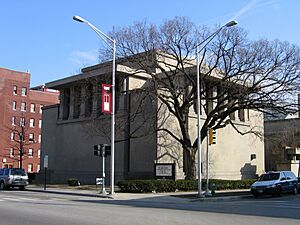
Arts and Culture
Oak Park has a very active arts community. This is partly because it's close to Chicago. It also has ties to famous artists like Ernest Hemingway, Frank Lloyd Wright, and Betty White. Many theater, music, dance, and fine-arts professionals live here. The arts district on Harrison Street has many art galleries, shops, and restaurants.
Oak Park is home to several professional dance and theater groups. These include Circle Theatre and Oak Park Festival Theatre. The Symphony of Oak Park and River Forest also performs here.
Oak Park is home to a radio station, WEUR, which has been broadcasting since 1950. It serves many different language and cultural groups in the Chicago area. The Oak Park Art League (OPAL) is a nonprofit art center. It offers classes, workshops, and exhibitions. It has been helping people enjoy art since 1921.
Oak Park also hosts many festivals and holiday events. The July 4th fireworks celebration brings thousands of people to the high school stadium. "A Day in Our Village" in June lets local groups share information and find new members.
Architecture and Historic Buildings

Frank Lloyd Wright spent the first 20 years of his career in Oak Park. He built many homes here, including his own house. You can see his earliest work here, like the Winslow House in nearby River Forest. Oak Park also has examples of his first "prairie-style" houses. He also designed Unity Temple, a church built between 1905 and 1908. Other famous architects worked in Wright's Oak Park Studio.
Many buildings in Oak Park were built by other "Prairie School" architects. These include George W. Maher and John Van Bergen.
Oak Park has many different styles of homes. They show how the village grew over the years. Since 1972, the village has worked to protect its historic buildings. There are 2,400 historic sites in Oak Park. Most are homes built in Queen Anne, Prairie School, and Craftsman styles. The village has three historic districts: Frank Lloyd Wright, Ridgeland-Oak Park, and Seward Gunderson.
Ernest Hemingway lived at 339 N. Oak Park Ave. for the first six years of his life. His house was restored in 1992. You can now take tours there through The Ernest Hemingway Foundation of Oak Park.
The main post office on Lake Street is in the Art Deco style. It was designed in 1933. It is part of the Ridgeland-Oak Park Historic District.
Places to Visit
- Birthplace of Ernest Hemingway
- Frank Lloyd Wright Home and Studio
- Unity Temple, designed by Frank Lloyd Wright
- Frank Lloyd Wright–Prairie School of Architecture Historic District
- Ridgeland–Oak Park Historic District
- Edgar Rice Burroughs homes
- Oak Park Conservatory
Notable People from Oak Park
Images for kids
See also
 In Spanish: Oak Park (Illinois) para niños
In Spanish: Oak Park (Illinois) para niños




